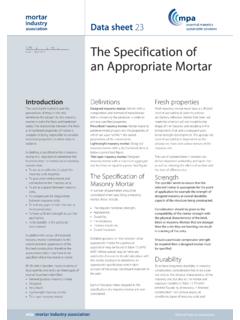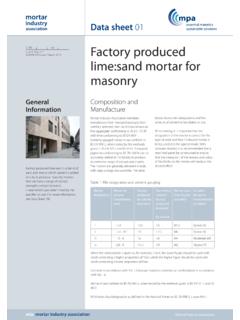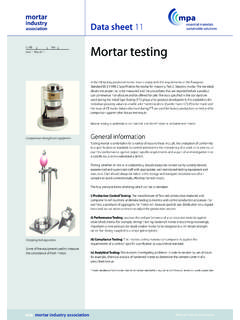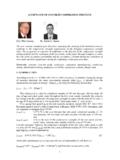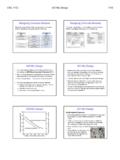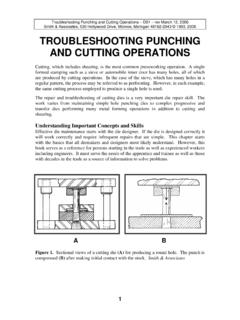Transcription of A guide to BS EN 998 -1 and BS EN 998 - 2
1 CI/SfBYq4 Issue 3 July 2015(Supersedes Issue February 2015)Data sheet 19A guide to BS EN 998 -1 and BS EN 998 - 2 IntroductionBS mortar and associated test method standards were withdrawn and replaced by harmonized European Product Standards and common test methods. In addition a revised British Standard covering those mortar test methods that were not part of the new European Standards, but was desired to be retained, has been withdrawnBS 4721:1981 Specification for ready-mixed building mortarsBS 5838-2:1980 Specification for dry packaged cementitious mixes - Pre-packed mortar mixesBS 4551: Methods of testing mortars screeds and plasters which is currently published in two parts is being republished as a single part Standard with the same Standard number.
2 A multi part Standard on mortar testing has been published as BS EN 1015PD 6472 guide to specifying the quality of building mortarsStandards/documents adoptedA new two part harmonized product Standard for mortar was published in EN 998-1 Specification for mortar for masonry - Part 1: Rendering and plastering mortarBS EN 998-2 Specification for mortar for masonry - Part 2: Masonry mortarPD 6678 guide to the selection and specification of masonry mortarThese documents are applicable to all mortars. However when applied to site mixed mortars they must be used in conjunction with the existing published document PB 6697. It should be noted that the Standards are not applicable when calcium sulfate is used as the principal binding ES 998-2 has been written using the performance concept, this is a departure from the traditional UK practice, which has been based primarily on a prescription (recipe) approach.
3 The recipe approach is based on the producer of the mortar batching prescribed proportions of materials, the performance concept requires the producer of the mortar to achieve a stated performance and allows the producer freedom to select the mix proportions to achieve recipes for screed materials have been listed in section 4 of BS 4721 and screed material testing covered by BS 4551. Screed materials are no longer within the scope of the mortar Standards and a separate series of Standards cover these products:BS EN 13318: Screed material and floor screeds - DefinitionsBS EN 13813: Screed material and floor screeds - Screed material - Properties and requirementsScreed material testing is covered by BS EN 13892, which is published in eight parts.
4 This data sheet does not discuss the new screed mortar industry associationMineral Products AssociationTerminologyThe introduction of the new Standards will result in the use of a number of new terms these include: Attestation system - this is the term used to describe the degree of involvement of third parties or the producer in assessing the conformity of the product in accordance with the technical specification. CE marking - this mark signifies that a product conforms to a harmonized European technical specification (European Standard or European Technical approval). Annex ZA of the relevant Standard lists the technical requirements for CE marking, for a product for a designated end use. Since the introduction of the Construction Products Regulation, CE marking is now mandatory in the UK.
5 Declared value - a value that the manufacturer is confident in achieving, bearing in mind the precision of the test and variability of the process. Evaluation of conformity - a systematic examination of the extent to which a product fulfils specified requirements. Harmonized Standard - a European Standard (EN) prepared under the mandate of the European Commission with the purpose of supporting a directive. A directive defines generic safety requirements. Initial type test - prior to placing a product on the market and when changes occur either in the constituent materials or production process which could affect the characteristics of the product, initial type testing, must be undertaken. The initial type tests that are necessary for each product are listed within the individual Standards.
6 Mandate - a formal request from the European commission to CEN (European Standards Organisation) to prepare a of MortarsBoth parts of BS EN 998 classify mortar in three different ways, the classification system is shown in Table 1: Classification of mortarAccording to location of finishedmanufactureAccording to conceptAccording topropertiesand usesBS EN 998-1 Rendering/plastering (i) Factory made(ii) Semi-finished(iii) Site made(i) Designed(ii) Prescribed(i) General purpose (GP)(ii) Lightweight* (LW )(iii) Coloured (CR)(iv) One coat for external use (OC)(v) Renovation# (R)(vi) Thermal insulating (T )BS EN 998-2 Masonry mortar(i) Factory made(ii) Semi-finished(iii) Pre-batched(iv) Premixed lime sand(v) Site made(i) Designed(ii) Prescribed(i) General purpose (G)(ii) Thin layer (T)(iii) Coloured (CR)
7 * A lightweight mortar is required to have a dry hardened density of less than 1300kg/m3 A thin layer masonry mortar is required to have a maximum aggregate particle size of 2mm# A renovation rendering mortar is designed for use on moist masonry walls containing soluble saltsMaterialsThe European Standards for both rendering mortars and masonry mortars require that constituent raw materials shall have characteristics which permit the finished product to conform to the requirements of the Standard. The European Standards require that constituent materials of established suitability be Mortar (BS EN 998-1)The manufacturer of the mortar is required to declare the workable life when the mortar contains an admixture to control the setting, testing should be undertaken in accordance with BS EN 1015-9.
8 It is a requirement of the Standard that the air content be tested and declared when relevant to the end use of the requirements for hardened rendering and plastering mortar are set out in Table 2: Classification for hardened rendering and plastering mortarsCompressive strength at 28 daysCapillary water absorptionThermal 0W 1W 2T 1T 2 Mean values0, 4 - 2, 5N/mm21, 5 - 5, 0N/mm23, 5 - 7, 5N/mm2> 6N/mm2 Not specifiedc 0, 40kg/m2 min 0, 5c 0, 20kg/m2 min 0, 5 0, 1 0, 2 bulk desnity(kg/m3) compressive strength (categories)Adhesion (N/mm2 and fracture pattern (FP) A, B or C) BS EN 1015-10BS EN 1015-11BS EN 1015-12BS EN 1015-21BS EN 1015-18BS EN 1015-18BS EN 1015-21BS EN 1015-19BS EN 174:2002 Table A12BS EN 174:2002 ofvalues1300Kg/m3CS I - IV Declared value and fracture pattern-W0 - W2-- Declared value--Declaredrange ofvaluesCS I - III Declared value and fracture pattern-W0 - W2-- Declared value--Declaredrange ofvaluesCS I - IV Declared value and fracture pattern-W0 - W2-- Declared value--Declaredrange ofvaluesCS I - IV-Declared value and fracture patternW1 - W2- 1ml/cm2after 48 hours Declared value--Declaredrange ofvaluesc Declared value and fracture pattern- after 24 hours 5mm- 15--Method of testGPTest ParameterLWCROCRTD eclaredrange ofvaluesCS I - II Declared value and fracture pattern-W1-- 15T1 after weathering cycles (N/mm2 and fracture pattern (FP) A, B or C) Capillary water absorption (kg/( )).
9 For mortars intended to be used in external elementsWater penetration after capillary water absorption test (in mm)Water permeability on relevant substrates after weathering cycles (ml/cm2 after 48 hours)Water vapour permeability coefficient ( ) for mortars intended to be used in external elementsThermal conductivity ( )For mortars intended to be used in elements subject to thermal requirementsTable 3: Requirements for hardened plastering and rendering mortarTable 3 lists the requirements for each of the classifications for rendering and plastering may declare density values for hardened plastering and rendering mortar when appropriate. Testing shall be carried out in accordance with BS EN manufacturer may if he wishes declare a value where a dash is indicated in a box.
10 There is a durability requirement for the determination of water penetration after completion of the capillary water absorption test, this is required to be undertaken in accordance with BS EN 1015-18 for One Coat rendering mortar (OC).Masonry mortar (BS EN 998-2)a The requirements for the properties of fresh masonry mortar are set out in Table 4. The mortar should be sampled in accordance with BS EN For thin layer mortars the correction time determined in accordance with BS EN 1015-9 shall be For designed Masonry mortars, the compressive strength classes illustrated are:M1, M2, 5, M5, M10, M15, M20. It is possible to have further strength classes where the manufacturer may declare other values in class Md. The compressive strength shall be determined on samples taken in accordance with BS EN 1015-2 and tested in accordance with BS EN 1015-11.
